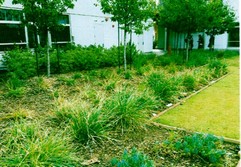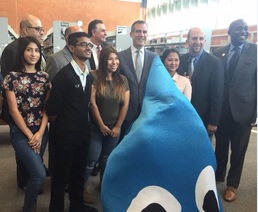 LA Unified has been tapped to receive $6M to develop more projects like this one at Torres HS, which features bioswales and raingardens.
LA Unified has been tapped to receive $6M to develop more projects like this one at Torres HS, which features bioswales and raingardens. Six LAUSD campuses have been selected by the California Water Resources Controls Board to receive $6 million to develop low-impact features through the state’s Drought Response Outreach Program for Schools (DROPS) and Proposition 84 grant programs.
These programs aim to create features that serve to capture, treat, and infiltrate storm water into groundwater basins to mimic a natural watershed. These features include bioswales, permeable pavement, infiltration galleries, rain-gardens, and cisterns.
The six selected campuses are Belvedere, Normandie and Victory Elementary schools; and Markham, Northridge and Webster Middle schools.
The District’s Architectural and Engineering group and Sustainability Initiatives Unit had initially identified these schools as being in critical need of site improvement and took advantage of DROPS program to develop comprehensive projects that address the deteriorated paving conditions while incorporating features crucial for capturing and infiltrating storm water. This also serves to recharge our local aquifers.
The DROPS grant also requires development and implementation of a robust education and outreach component at each school, so while the LID features will vary by campus, each project includes benefits extending to the classroom and beyond. Through partnership with the Council for Watershed Health, TreePeople and Los Angeles Audubon Society, the LID features will serve as outdoor, experiential classrooms and learning laboratories that can be incorporated into the curriculum and activities at school. Students will be engaged during design and construction, and will create signage and collaborate on aspects such as plant selection. Additional DROPS program components include field trips, student leadership training, professional development, teacher trainings, and formation of eco-clubs.
“We are excited to be working with the State Water Resources Control Board to implement these crucial projects. We are looking forward to partnering with the Council for Watershed Health and community-based organizations to engage students and raise awareness in the community about the importance of storm water management and stewardship of our local aquifers,” said Christos Chrysiliou, Director of the Architectural and Engineering Services unit of the Facilities Services Division. District.
The District’s DROPS program also includes staff training for Maintenance & Operations employees responsible for managing the LID features and maintaining the native landscaping. The DROPS LID program will serve as a model for other schools and districts seeking to use water resource management as a tool for education and advocacy.
These programs aim to create features that serve to capture, treat, and infiltrate storm water into groundwater basins to mimic a natural watershed. These features include bioswales, permeable pavement, infiltration galleries, rain-gardens, and cisterns.
The six selected campuses are Belvedere, Normandie and Victory Elementary schools; and Markham, Northridge and Webster Middle schools.
The District’s Architectural and Engineering group and Sustainability Initiatives Unit had initially identified these schools as being in critical need of site improvement and took advantage of DROPS program to develop comprehensive projects that address the deteriorated paving conditions while incorporating features crucial for capturing and infiltrating storm water. This also serves to recharge our local aquifers.
The DROPS grant also requires development and implementation of a robust education and outreach component at each school, so while the LID features will vary by campus, each project includes benefits extending to the classroom and beyond. Through partnership with the Council for Watershed Health, TreePeople and Los Angeles Audubon Society, the LID features will serve as outdoor, experiential classrooms and learning laboratories that can be incorporated into the curriculum and activities at school. Students will be engaged during design and construction, and will create signage and collaborate on aspects such as plant selection. Additional DROPS program components include field trips, student leadership training, professional development, teacher trainings, and formation of eco-clubs.
“We are excited to be working with the State Water Resources Control Board to implement these crucial projects. We are looking forward to partnering with the Council for Watershed Health and community-based organizations to engage students and raise awareness in the community about the importance of storm water management and stewardship of our local aquifers,” said Christos Chrysiliou, Director of the Architectural and Engineering Services unit of the Facilities Services Division. District.
The District’s DROPS program also includes staff training for Maintenance & Operations employees responsible for managing the LID features and maintaining the native landscaping. The DROPS LID program will serve as a model for other schools and districts seeking to use water resource management as a tool for education and advocacy.

